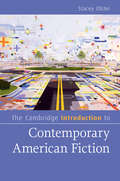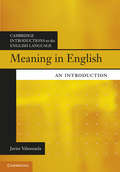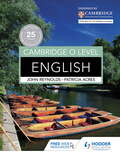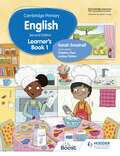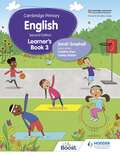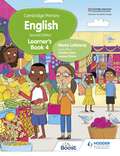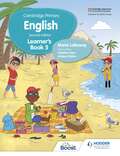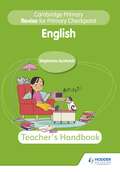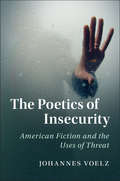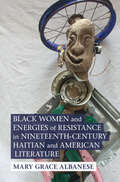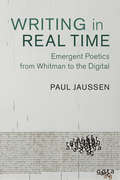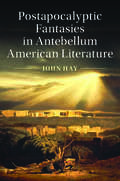- Table View
- List View
Cambridge Introductions to Language and Linguistics: Introducing Syntax
by Olaf Koeneman Hedde ZeijlstraSyntax is the study of how sentences are built. Whereas the grammar of English (or other languages) might look like a rather chaotic set of arbitrary patterns, linguistic science has revealed that these patterns can actually be understood as a result of a small number of grammatical principles. This lively introductory textbook is designed for undergraduate students in linguistics, English and modern languages with relatively little background in the subject, offering the necessary tools for the analysis of phrases and sentences, while at the same time introducing state-of-the-art syntactic theory, in an accessible and engaging way. Guiding students through a variety of intriguing puzzles, striking facts and novel ideas, Introducing Syntax presents contemporary insights behind syntactic theory in one clear and coherent narrative, avoiding unnecessary technical detail and enabling readers to understand the rationale behind technicalities. Learning features include highlighted key terms, further reading suggestions and numerous exercises and activities throughout, placing syntax in a broader grammatical perspective.
Cambridge Introductions to Literature: The Cambridge Introduction to British Poetry, 1945–2010
by Eric FalciThe Cambridge Introduction to British Poetry, 1945–2010 provides a broad overview of an important body of poetry from England, Scotland, Wales, and Northern Ireland from the postwar period through to the twenty-first century. It offers a comprehensive view of the historical context surrounding the poetry and provides in-depth readings of many of the period's central poets. British poetry after 1945 has been given much less attention than both earlier British and American poetry, as well as postwar American poetry. There are very few single-author studies that present the entirety of the period's poetry. This book is unique for the comprehensive richness with which it presents the historical and literary-historical scene, as well as for its close-up focus on a wide range of major poets and poems.
Cambridge Introductions to Literature: The Cambridge Introduction to Contemporary American Fiction (Cambridge Introductions To Literature Ser.)
by Stacey OlsterThe Cambridge Introduction to Contemporary American Fiction explores fiction written over the last thirty years in the context of the profound political, historical, and cultural changes that have distinguished the contemporary period. Focusing on both established and emerging writers - and with chapters devoted to the American historical novel, regional realism, the American political novel, the end of the Cold War and globalization, 9/11, borderlands and border identities, race, and the legacy of postmodern aesthetics - this Introduction locates contemporary American fiction at the intersection of a specific time and long-standing traditions. In the process, it investigates the entire concept of what constitutes an "American" author while exploring the vexed, yet resilient, nature of what the concept of home has come to signify in so much writing today. This wide-ranging study will be invaluable to students, instructors, and general readers alike.
Cambridge Introductions to Literature: The Cambridge Introduction to Postmodernism
by Brian MchaleThe Cambridge Introduction to Postmodernism surveys the full spectrum of postmodern culture - high and low, avant-garde and popular, famous and obscure - across a range of fields, from architecture and visual art to fiction, poetry, and drama. It deftly maps postmodernism's successive historical phases, from its emergence in the 1960s to its waning in the first decades of the twenty-first century. Weaving together multiple strands of postmodernism - people and places from Andy Warhol, Jefferson Airplane, and magical realism to Jean-François Lyotard, Laurie Anderson, and cyberpunk - this book creates a rich picture of a complex cultural phenomenon that continues to exert an influence over our present "post-postmodern" situation. Comprehensive and accessible, this Introduction is indispensable for scholars, students, and general readers interested in late-twentieth-century culture.
Cambridge Introductions to the English Language: Meaning in English
by Javier ValenzuelaThis lively, compact textbook introduces readers to semantics - the study of how we construct meaning in communication. Easy to follow, and with a clear structure, it explains formal terminology in a simple and understandable way, without using formal notation or logic, and draws on dozens of examples from up-to-date empirical research findings. Offering a tight integration of classic semantic issues with cognitive science, Javier Valenzuela provides a complete and coherent overview of the main topics in this area, including a review of the empirical methods used in semantic theorizing, and discussions of both non-traditional and new topics, such as how meaning is acquired by children and how meaning is constructed cross-linguistically. Featuring illustrations, exercises, activities, suggestions for further reading, highlighted key terms, and a comprehensive glossary, this book is accessible to beginners and undergraduates, including those from non-linguistic backgrounds with no prior knowledge of linguistic analysis. It will be an essential resource for courses in English language, English studies, linguistics and the cognitive sciences.
Cambridge Introductions to…: The Cambridge Introduction to French Literature
by Brian NelsonIn this highly accessible introduction, Brian Nelson provides an overview of French literature - its themes and forms, traditions and transformations - from the Middle Ages to the present. Major writers, including Francophone authors writing from areas other than France, are discussed chronologically in the context of their times, to provide a sense of the development of the French literary tradition and the strengths of some of the most influential writers within it. Nelson offers close readings of exemplary passages from key works, presented in English translation and with the original French. The exploration of the work of important writers, including Villon, Racine, Molière, Voltaire, Balzac, Flaubert, Zola, Proust, Sartre and Beckett, highlights the richness and diversity of French literature.
Cambridge Introductions to…: The Cambridge Introduction to Theatre and Literature of the Absurd
by Michael Y. BennettMichael Y. Bennett's accessible Introduction explains the complex, multidimensional nature of the works and writers associated with the absurd - a label placed upon a number of writers who revolted against traditional theatre and literature in both similar and widely different ways. Setting the movement in its historical, intellectual and cultural contexts, Bennett provides an in-depth overview of absurdism and its key figures in theatre and literature, from Samuel Beckett and Harold Pinter to Tom Stoppard. Chapters reveal the movement's origins, development and present-day influence upon popular culture around the world, employing the latest research to this often challenging area of study in a balanced and authoritative approach. Essential reading for students of literature and theatre, this book provides the necessary tools to interpret and develop the study of a movement associated with some of the twentieth century's greatest and most influential cultural figures.
Cambridge O Level English
by John Reynolds Patricia AcresEnsure full coverage of the latest syllabus for examination from 2018 with a full-colour textbook written especially for the international student and endorsed by Cambridge AssessmentInternational Education.- Engage students with a wide range of extracts featuring different types of text from around the world- Develop writing and reading skills with tips on how to approach different types of writing and plenty of practice exercises in each unit- Prepare your students for their examination with practice questions and exam preparation advice
Cambridge Primary English Learner's Book 1 Second Edition
by Sarah SnashallThis title has been endorsed by Cambridge Assessment International Education Inspire learners to build, strengthen and extend their skills. Written by experienced authors and primary practitioners, Cambridge Primary English offers full coverage of the new Cambridge Primary English curriculum framework (0058). - Boost confidence and extend understanding: Tasks built in a three-step approach with 'Learn', 'Get started!' and 'Go further' plus 'Challenge yourself' activities to support differentiation and higher order thinking skills. - Revisit, practice and build on previous learning: Let learners see how their skills are developing with 'What can you remember?' checklists at the end of each unit and self-check practice quizzes. - Develop key concepts and skills: A variety of practice material throughout to build Reading, Writing, Speaking and Listening skills. - Motivate learners with an international approach: The learner's books provide a variety of engaging extracts from diverse international authors covering fiction genres, non-fiction text types, poetry and plays.
Cambridge Primary English Learner's Book 2 Second Edition
by Sarah SnashallThis title has been endorsed by Cambridge Assessment International Education Inspire learners to build, strengthen and extend their skills. Written by experienced authors and primary practitioners, Cambridge Primary English offers full coverage of the new Cambridge Primary English curriculum framework (0058). - Boost confidence and extend understanding: Tasks built in a three-step approach with 'Learn', 'Get started!' and 'Go further' plus 'Challenge yourself' activities to support differentiation and higher order thinking skills. - Revisit, practice and build on previous learning: Let learners see how their skills are developing with 'What can you remember?' checklists at the end of each unit and self-check practice quizzes. - Develop key concepts and skills: A variety of practice material throughout to build Reading, Writing, Speaking and Listening skills. - Motivate learners with an international approach: The learner's books provide a variety of engaging extracts from diverse international authors covering fiction genres, non-fiction text types, poetry and plays.
Cambridge Primary English Learner's Book 3 Second Edition
by Sarah SnashallThis title has been endorsed by Cambridge Assessment International Education Inspire learners to build, strengthen and extend their skills. Written by experienced authors and primary practitioners, Cambridge Primary English offers full coverage of the new Cambridge Primary English curriculum framework (0058). - Boost confidence and extend understanding: Tasks built in a three-step approach with 'Learn', 'Get started!' and 'Go further' plus 'Challenge yourself' activities to support differentiation and higher order thinking skills. - Revisit, practice and build on previous learning: Let learners see how their skills are developing with 'What can you remember?' checklists at the end of each unit and self-check practice quizzes. - Develop key concepts and skills: A variety of practice material throughout to build Reading, Writing, Speaking and Listening skills. - Motivate learners with an international approach: The learner's books provide a variety of engaging extracts from diverse international authors covering fiction genres, non-fiction text types, poetry and plays.
Cambridge Primary English Learner's Book 4 Second Edition
by Marie LallawayThis title has been endorsed by Cambridge Assessment International Education Inspire learners to build, strengthen and extend their skills. Written by experienced authors and primary practitioners, Cambridge Primary English offers full coverage of the new Cambridge Primary English curriculum framework (0058). - Boost confidence and extend understanding: Tasks built in a three-step approach with 'Learn', 'Get started!' and 'Go further' plus 'Challenge yourself' activities to support differentiation and higher order thinking skills. - Revisit, practice and build on previous learning: Let learners see how their skills are developing with 'What can you remember?' checklists at the end of each unit and self-check practice quizzes. - Develop key concepts and skills: A variety of practice material throughout to build Reading, Writing, Speaking and Listening skills. - Motivate learners with an international approach: The learner's books provide a variety of engaging extracts from diverse international authors covering fiction genres, non-fiction text types, poetry and plays.
Cambridge Primary English Learner's Book 5 Second Edition
by Marie LallawayWe are working with Cambridge Assessment International Education to gain endorsement for this forthcoming title. Inspire learners to build, strengthen and extend their skills. Written by experienced authors and primary practitioners, Cambridge Primary English offers full coverage of the new Cambridge Primary English curriculum framework (0058). - Boost confidence and extend understanding: Tasks built in a three-step approach with 'Learn', 'Get started!' and 'Go further' plus 'Challenge yourself' activities to support differentiation and higher order thinking skills. - Revisit, practice and build on previous learning: Let learners see how their skills are developing with 'What can you remember?' checklists at the end of each unit and self-check practice quizzes. - Develop key concepts and skills: A variety of practice material throughout to build Reading, Writing, Speaking and Listening skills. - Motivate learners with an international approach: The learner's books provide a variety of engaging extracts from diverse international authors covering fiction genres, non-fiction text types, poetry and plays.
Cambridge Primary English Learner's Book 6 Second Edition
by Marie LallawayThis title has been endorsed by Cambridge Assessment International Education Inspire learners to build, strengthen and extend their skills. Written by experienced authors and primary practitioners, Cambridge Primary English offers full coverage of the new Cambridge Primary English curriculum framework (0058). - Boost confidence and extend understanding: Tasks built in a three-step approach with 'Learn', 'Get started!' and 'Go further' plus 'Challenge yourself' activities to support differentiation and higher order thinking skills. - Revisit, practice and build on previous learning: Let learners see how their skills are developing with 'What can you remember?' checklists at the end of each unit and self-check practice quizzes. - Develop key concepts and skills: A variety of practice material throughout to build Reading, Writing, Speaking and Listening skills. - Motivate learners with an international approach: The learner's books provide a variety of engaging extracts from diverse international authors covering fiction genres, non-fiction text types, poetry and plays.
Cambridge Primary Revise for Primary Checkpoint English Study Guide 2nd edition
by Stephanie AustwickBuild, reinforce and assess knowledge with additional practice and revision activities for all strands of the Cambridge Primary curriculum frameworks.- Boost confidence and check students' progress with review tests and practice questions.- Improve technique with a range of engaging activities and worked examples.- Consolidate knowledge with key content presented in a manageable and focussed format.The Cambridge Primary Revise for Study Guides can be used independently for homework or additionalpractice, or alongside the Teacher's Guides in the classroom.This resource has not been through the Cambridge International endorsement process.
Cambridge Primary Revise for Primary Checkpoint English Teacher's Handbook 2nd edition
by Stephanie AustwickFocus revision where learners need most support and ensure coverage of the Cambridge Primary English curriculum framework with clearly identified learning objectives and easy-to-follow teaching notes.- Assess knowledge and progress with Let's Revise! sections, structured practice tests and whole-class activities.- Improve understanding and technique with photocopiable resources such as model texts, practice questions, worksheets and games.- Introduce strategies for supporting recall and revision with further ideas to stretch students, with marking guidance.
Cambridge Primary Revise for Primary Checkpoint World English Study Guide
by Daphne Paizee Fiona MacgregorBuild, reinforce and assess knowledge with additional practice and revision activities for all strands of the Cambridge Primary curriculum frameworks.- Boost confidence and check students' progress with review tests and practice questions.- Improve technique with a range of engaging activities and worked examples.- Consolidate knowledge with key content presented in a manageable and focussed format.The Cambridge Primary Revise for Study Guides can be used independently for homework or additionalpractice, or alongside the Teacher's Guides in the classroom.This resource has not been through the Cambridge International endorsement process.
Cambridge Studies in American Literature and Culture: American Fiction and the Uses of Threat (Cambridge Studies in American Literature and Culture #165)
by Johannes VoelzThe Poetics of Insecurity turns the emerging field of literary security studies upside down. Rather than tying the prevalence of security to a culture of fear, Johannes Voelz shows how American literary writers of the past two hundred years have mobilized insecurity to open unforeseen and uncharted horizons of possibility for individuals and collectives. In a series of close readings of works by Charles Brockden Brown, Harriet Jacobs, Willa Cather, Flannery O'Connor, and Don DeLillo, Voelz brings to light a cultural imaginary in which conventional meanings of security and insecurity are frequently reversed, so that security begins to appear as deadening and insecurity as enlivening. Timely, broad-ranging, and incisive, Johannes Voelz's study intervenes in debates on American literature as well as in the interdisciplinary field of security studies. It fundamentally challenges our existing explanations for the pervasiveness of security in American cultural and political life.
Cambridge Studies in American Literature and Culture: Black Women and Energies of Resistance in Nineteenth-Century Haitian and American Literature (Cambridge Studies In American Literature And Culture Ser.)
by Mary Grace AlbaneseCambridge Studies in American Literature and Culture: Emergent Poetics from Whitman to the Digital (Cambridge Studies in American Literature and Culture #163)
by Paul JaussenFrom Walt Whitman to the contemporary period, the long poem has been one of the more dynamic, intricate, and yet challenging literary practices of modernity. Addressing those challenges, Writing in Real Time combines systems theory, literary history, and recent debates in poetics to interpret a broad range of American long poems as emergent systems, capable of adaptation and transformation in response to environmental change. Due to these emergent properties, the long poem performs essential cultural work, offering a unique experience of history that remains valuable for our rapidly transforming digital age. Moving across a broad range of literary and theoretical texts, Writing in Real Time demonstrates that the study of emergence can enhance literary scholarship, just as literature provides unique insights into emergent properties, making this book a key resource for scholars, graduate students, and undergraduate students alike.
Cambridge Studies in American Literature and Culture: Fictions of Mass Democracy in Nineteenth-Century America
by Stacey MargolisFictions of Mass Democracy in Nineteenth-Century America examines how mass democracy was understood before public opinion could be measured by polls. It argues that fiction, in its freedom to represent what resists representation, develops the most groundbreaking theories of the democratic public. These literary accounts of democracy focus less on overt pubic action than the profound effects of everyday social encounters. This book thus departs from recent scholarship, which emphasizes the responsibilities of citizenship and the achievements of oppositional social movements. It demonstrates how novels and stories by Charles Brockden Brown, Edgar Allan Poe, Nathaniel Hawthorne, Herman Melville, Fanny Fern, Harriet Jacobs and James Fenimore Cooper attempt to understand a public organized not only by explicitly political discourse, but by informal and disorganized social networks.
Cambridge Studies in American Literature and Culture: Hobbes, Sovereignty, and Early American Literature
by Paul DownesHobbes, Sovereignty, and Early American Literature pursues the question of democratic sovereignty as it was anticipated, theorized and resisted in the American colonies and in the early United States. It proposes that orthodox American liberal accounts of political community need to be supplemented and challenged by the deeply controversial theory of sovereignty that was articulated in Thomas Hobbes's Leviathan (1651). This book offers a radical re-evaluation of Hobbes's political theory and demonstrates how a renewed attention to key Hobbesian ideas might inform inventive re-readings of major American literary, religious and political texts. Ranging from seventeenth- and eighteenth-century Puritan attempts to theorize God's sovereignty to revolutionary and founding-era debates over popular sovereignty, this book argues that democratic aspiration still has much to learn from Hobbes's Leviathan and from the powerful liberal resistance it has repeatedly provoked.
Cambridge Studies in American Literature and Culture: Nineteenth-Century American Literature and the Long Civil War
by Cody MarrsAmerican literature in the nineteenth century is often divided into two asymmetrical halves, neatly separated by the Civil War. In Nineteenth-Century American Literature and the Long Civil War, Cody Marrs argues that the war is a far more elastic boundary for literary history than has frequently been assumed. Focusing on the later writings of Walt Whitman, Frederick Douglass, Herman Melville, and Emily Dickinson, this book shows how the war took imaginative shape across, and even beyond, the nineteenth century, inflecting literary forms and expressions for decades after 1865. These writers, Marrs demonstrates, are best understood not as antebellum or postbellum figures but as transbellum authors who cipher their later experiences through their wartime impressions and prewar ideals. This book is a bold, revisionary contribution to debates about temporality, periodization, and the shape of American literary history.
Cambridge Studies in American Literature and Culture: Postapocalyptic Fantasies in Antebellum American Literature (Cambridge Studies in American Literature and Culture #164)
by John HayEven before the Civil War, American writers were imagining life after a massive global catastrophe. For many, the blank slate of the American continent was instead a wreckage-strewn wasteland, a new world in ruins. Bringing together epic and lyric poems, fictional tales, travel narratives, and scientific texts, Postapocalyptic Fantasies in Antebellum American Literature reveals that US authors who enthusiastically celebrated the myths of primeval wilderness and virgin land also frequently resorted to speculations about the annihilation of civilizations, past and future. By examining such postapocalyptic fantasies, this study recovers an antebellum rhetoric untethered to claims for historical exceptionalism - a patriotic rhetoric that celebrates America while denying the United States a unique position outside of world history. As the scientific field of natural history produced new theories regarding biological extinction, geological transformation, and environmental collapse, American writers responded with wild visions of the ancient past and the distant future.
Cambridge Studies in American Literature and Culture: The Poetry of Disturbance
by David BergmanIn The Poetry of Disturbance, David Bergman argues that post-war poetry underwent a significant if subtle shift in emphasis, moving from the modernist concern with the poem as a visual text to one that was chiefly oral in nature. The resulting change was disturbing, especially for those brought up on the principles of high modernism. This new stress on orality implied a shift in the economy of the poem, away from the austerity of language advocated by Pound and Eliot to a style that conveyed freedom, expansiveness, and an innovative directness.

